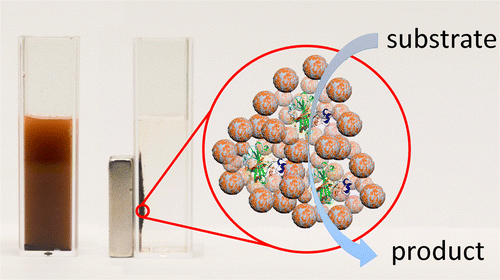Authors: Drozdov A. S., Shapovalova O.E., Ivanovski. V., Avnir D., Vinogradov V.V.

Abstract
Magnetically controlled enzymatic composites have received much attention for both therapeutic and industrial applications. Until now, such materials have been composed of at least four components: the enzyme, magnetic nanoparticles, their stabilizing components, and an organic or inorganic (or hybrid) matrix as a carrier. However, such compositions affect the magnetic response and the enzymatic activity, and also pose obstacles for intravenous administration, because of regulatory restrictions. Here, we present a methodology for the creation of magnetic bioactive nanocomposites composed of only two biocompatible components: an enzyme and magnetite nanoparticles. A series of magnetic biocomposites with a full set of therapeutical and industrial proteins (carbonic anhydrase, ovalbumin, horseradish peroxidase, acid phosphatase, proteinase, and xylanase) were successfully created by the direct entrapment of the proteins within a sol–gel magnetite matrix specially developed for these aims. The activity of the entrapped enzymes was studied at different temperatures and concentrations, and it was found that they showed remarkable thermal stabilization induced by the ferria matrix. For instance, entrapped carbonic anhydrase catalyzed the decomposition of p-nitrophenylacetate at a temperature of 90 °C, while free enzyme completely loses activity and denaturates already at 70 °C. Magnetic characterization of the obtained biomaterials is provided.
DOI: 10.1021/acs.chemmater.6b00193
Read Full Here:
https://pubs.acs.org/doi/abs/10.1021/acs.chemmater.6b00193